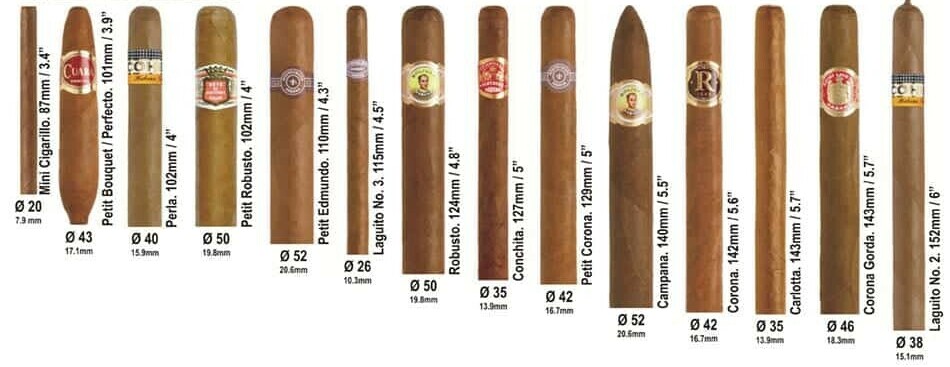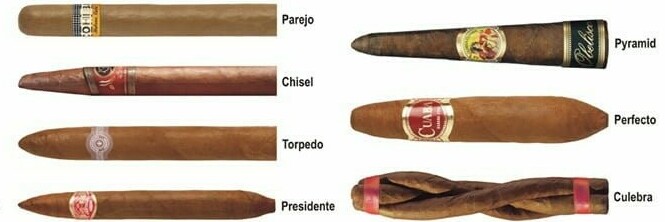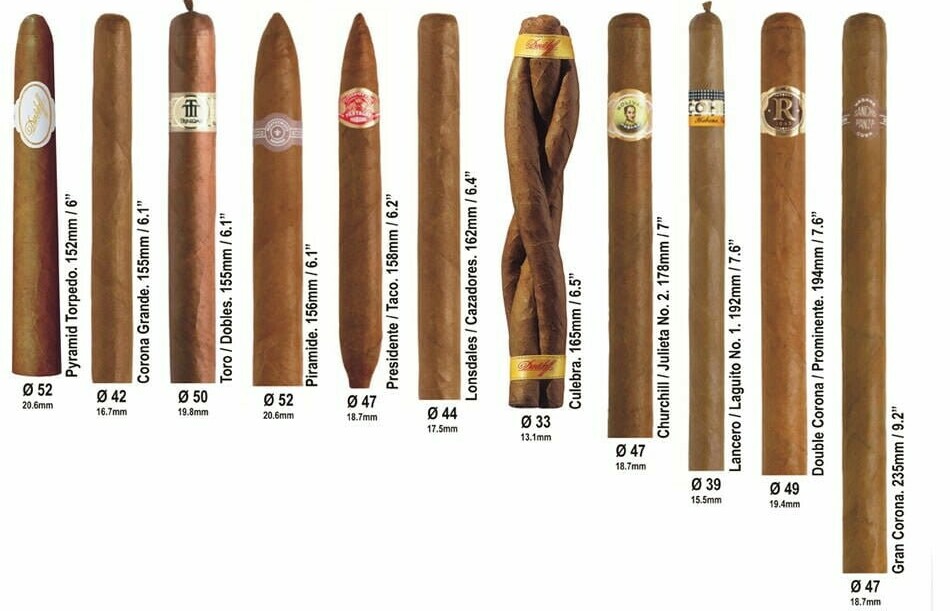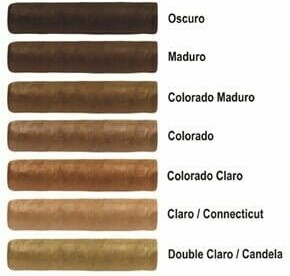When you’re getting acquainted with cigars, the variety of shapes can be quite bewildering. But it’s the cigar’s shape, or its ‘vitola,’ that largely influences how you enjoy it. That’s why I believe knowing the various shapes is as crucial as being able to light one correctly.
Different shapes, each with its own name and history, not only contribute to the aesthetic appeal but also affect the smoking experience. The shape affects the draw—how the smoke flows through the cigar—and the rate of combustion, which together influence the intensity of flavors you experience with each puff. The most straightforward cigar shapes are classified as ‘Parejos.’ These include classics like the robusto, corona, and Churchill—straight-sided cylinders that are capped at one end. These shapes are ideal for beginners, due to their uniformity and consistency in draw.
The most straightforward cigar shapes are classified as ‘Parejos.’ These include classics like the robusto, corona, and Churchill—straight-sided cylinders that are capped at one end. These shapes are ideal for beginners, due to their uniformity and consistency in draw.
On the other hand, ‘Figurados’—irregularly shaped cigars such as torpedoes, pyramids, and perfectos—offer a more complex smoking experience. They have tapered ends which can concentrate flavors and make for a more intense smoking session. Perfect for enthusiasts who seek something a bit more challenging.
Matching the right cigar shape with your smoking preferences can greatly enhance your enjoyment. Becoming familiar with each shape’s characteristics will allow you to anticipate the kind of smoking journey you’re about to have, whether you’re in the mood for a leisurely burn or a more intense, nuanced smoke.
 Equipped with this shape savvy, you may now find yourself wanting to dig deeper into the intricacies of cigars. And what better place to continue your learning than by grasping the concept of cigar sizes? Size, after all, is just as pivotal in crafting the perfect cigar experience.
Equipped with this shape savvy, you may now find yourself wanting to dig deeper into the intricacies of cigars. And what better place to continue your learning than by grasping the concept of cigar sizes? Size, after all, is just as pivotal in crafting the perfect cigar experience.
Measuring Up: The Significance of Cigar Sizes
Cigar sizes might perplex newcomers, but they are straightforward once you understand the lingo. Manufacturers use terms like ‘ring gauge’ and ‘length’ to describe a cigar’s dimensions, and these numbers are not random. The ring gauge is the diameter of a cigar in sixty-fourths of an inch. So, if a cigar has a ring gauge of 64, it’s one inch in diameter. A vast array of sizes exist, ranging from slim, short models to thick, long ones. This isn’t merely about aesthetics; the size affects how long you can enjoy a smoke and how the flavors develop over time. Larger cigars often provide a longer-lasting experience and a more complex taste, as the blend of tobaccos has a larger ‘canvas’ to work on.
A vast array of sizes exist, ranging from slim, short models to thick, long ones. This isn’t merely about aesthetics; the size affects how long you can enjoy a smoke and how the flavors develop over time. Larger cigars often provide a longer-lasting experience and a more complex taste, as the blend of tobaccos has a larger ‘canvas’ to work on.
The range of cigar sizes includes names like ‘Robusto,’ ‘Churchill,’ and ‘Corona,’ each with its own dimensions and character. A Robusto, typically 5 inches long with a ring gauge of 50, offers a balanced smoking time. A Churchill, in contrast, is usually 7 inches with a similar gauge, allowing for an extended experience, often preferred after a hearty meal.
When you’re picking out a cigar, think about the time you have available and the intensity of flavor you’re seeking. A smaller ring gauge tends to concentrate the taste more, delivering a richer flavor, while larger gauges mellow out the intensity, making for a smoother draw.
So, keep the dimension in mind next time you select a cigar. Understand that a cigar isn’t just a simple pleasure, but a carefully crafted experience where size truly does matter.
Shades of Taste: Understanding Cigar Colors
I’ve walked you through the labyrinth of cigar shapes and sizes, and now it’s time for the final reveal—colors. When you examine a cigar, the wrapper not only catches your eye but also hints at the sensory adventure that awaits. The color palette of cigar wrappers ranges from nearly blonde to profoundly dark, and each color has a story steeped in the craft of cigar making.

The lightest wrappers, known as “Claro,” offer a delicate, mild flavor that can be the perfect introduction for newcomers. Venture further into the color scale and you’ll encounter “Colorado” and “Maduro” shades, with richer and more complex tastes. These darker hues often imply a bolder, sweeter experience, deeply rooted in prolonged fermentation and meticulous aging processes.
It’s tempting to assume that a darker cigar is stronger, but color is not the only gauge of strength. The taste is multifaceted, influenced by the blend of tobaccos within. Understanding this helps avoid hasty judgments based solely on the wrapper’s shade. After all, a cigar is a composition of its parts, not just the outer leaf.
In drawing our exploration to a close, I hope these insights into cigar colors have cleared the mist. Let color be your guide, but not your sole adviser. Taste, experience, and sometimes even the day’s mood will swing your choice. Whether you’re a seasoned aficionado or a curious beginner, let your palate lead the way and enjoy the rich tapestry that is cigar appreciation.
The Last Puff
Choosing just one shape, strength, and color of a cigar to bring to a desert island is a difficult decision for any seasoned cigar smoker. However, for the purposes of this article, a full strength Toro with a maduro wrapper, measuring 6 inches in length and with a ring size of 50-52, seems like the perfect choice for me. The smoke time of 45 to 50 minutes is ideal. Of course, if we’re on a desert island, the time spent smoking may not really matter. So, what would you choose to bring with you? Share your answer below, as I would love to hear it.
